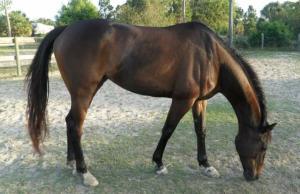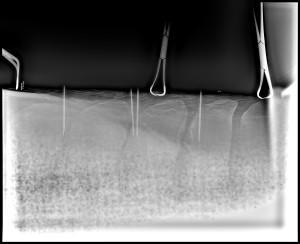OTTB Gets a Second Chance at New Career Thanks to PBEC

Palm Beach Equine Clinic is renowned for its exceptional care of performance sport horses of all disciplines around the world. Sometimes, the veterinarians and surgeons have the opportunity to treat the horses owned by their colleagues. This summer, Palm Beach Equine Clinic veterinary technician Megan O’Neal experienced the clinic’s surgical expertise firsthand when her rescued off the track Thoroughbred (OTTB) was diagnosed with severe spinal impingement (kissing spines).
Signs and Symptoms
O’Neal adopted Blessing, a 10-year-old mare, almost three years ago. After Blessing’s career on the track ended, she was given to Pure Thoughts Horse Rescue in Wellington, FL. Blessing had moved through a few foster homes before O’Neal gave her a forever home. Blessing had been successfully jumping three-foot courses with one of her previous foster homes. After adopting Blessing, O’Neal was jumping the mare as well, but only about two-feet high. She had plans to compete, but Blessing’s behavior changed under saddle. The mare began rearing and bolting, endangering both herself and her rider. Her attitude on ground handling turned sour as well, no longer enjoying being groomed and pinning her ears in agitation.
Identifying the Problem

With the help of Palm Beach Equine Clinic surgeon Dr. Weston Davis and the advanced imaging technology available at PBEC, O’Neal was able to pinpoint the cause of Blessing’s troubling change in behavior. The diagnosis was severe chronic back pain with dorsal spinous process impingement (kissing spine lesions). The vertebrae in her back from T16 – L1 were affected, which is the mid-section of the horse’s back, in the general region of where the back of the saddle sits.
Addressing the Problem Through Non-Surgical Treatments
The first course of action was to try several non-surgical techniques to treat Blessing’s pain. Dr. Davis tried treatments of intramuscular injections for arthritic pain and corticosteroid injections in between the spinal vertebras. A veterinary chiropractor adjusted the mare every few weeks. For almost eight months, several additional methods were tried to avoid kissing spines surgery including acupuncture, back stretches and oral muscle relaxants. In July, when the pain continued after all their efforts, O’Neal finally decided that surgery was the only option for recovery.
Kissing Spines Surgery
In the state-of-the-art hospital at Palm Beach Equine Clinic, Blessing was sedated to obtain pre-operative radiographs that map the exact site of the lesions. She was placed under general anesthesia and the surgical site was sterilely prepared. Dr. Davis made a single 20cm incision on the dorsal midline over the palpable dorsal spinous processes. Eighteen-gauge needles were inserted at regular intervals and used as radiographic markers to identify the interspinous spaces. The incision was extended through the supraspinous ligament at each site.

Dr. Davis used sterile surgical equipment, known as a bone rongeur, to elevate the soft tissues and resect some of the affected dorsal spinous processes (DSPs). The rongeurs, which are similar to large pliers, were used to slowly remove the edges of the overriding bone. This process frees the space between adjacent vertebrae until widened enough that the index finger of the surgeon could easily pass in the interspinous space. The site of resection was lavaged to remove any loosed tissues. Lastly, Intra-operative radiography was used as needed to confirm the location and completion of the surgery. Following confirmation, the supraspinous ligament was internally closed with absorbable sutures. The skin was closed with surgical staples and a stent was sutured in place over the incision. After several weeks of healing, the stent and staples were removed.
The kissing spines surgery was performed without complication and Blessing was provided a good prognosis. Soon after surgery, the space that was created between vertebrae filled with a non-painful, fibrous scar tissue. Blessing went home the following day after surgery. She was monitored closely at home and received routine peri-operative antibiotics (gentamicin and penicillin) and anti-inflammatories (phenylbutazone) for pain. Recently, O’Neal was given the okay from Dr. Davis to resume riding for normal exercise. O’Neal looks forward to continuing her partnership with this special mare. Thanks to Dr. Weston Davis and the team at Palm Beach Equine Clinic for their exceptional care to get Blessing back to happy and healthy!